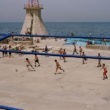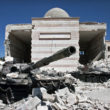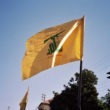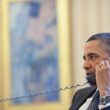Shortly after the horrific explosion at a warehouse in the port of Beirut that killed some 200 persons and wounded many thousands more, Gordon Duff, the editor of Veterans Today, posted a YouTube video in which he stated that he had been in a conversation with a retired Lebanese general who claimed that the blast was the result of an Israeli attack.
According to Duff’s source, the Israeli attack involved two separate munitions. The first, a sea-based missile fired from off the coast of Beirut, struck the warehouse, starting a fire. Shortly thereafter, an Israeli F-16 dropped what Duff called a “tactical nuclear weapon,” causing a massive explosion that destroyed the warehouse, the port facilities, and many surrounding buildings. President Trump’s offhand claim that the Beirut explosion was “an attack” helped breathe life into Duff’s story (Trump later walked his remark back).
Duff and Veterans Today have a history of generating anti-Israeli content that, according to the Southern Poverty Law Center, consists of “an endless stream of Israel-bashing mixed in with some bona fide anti-Semitism,” and as such should be treated with a healthy bit of skepticism. So, too, should the fact that Duff cites as a principal source a man named Jeff Smith, who Duff claims is a former International Atomic Energy Agency inspector and nuclear weapons expert. Duff’s relationship with Smith began in 2014. Smith claimed that he was the “lead investigator” for the IAEA in both Iran and Syria and a member of a joint agency unit known as Able Danger, which, according to Smith, investigated missing nuclear material affiliated with the Strategic Arms Reduction Treaty, or START.
Jeff Smith’s claims do not survive even the most cursory of investigations: his name appears nowhere in any IAEA reporting regarding Iran or Syria, and his “U.N. diplomatic passport” (in Duff’s words) containing visas “signed by the Secretary General” is almost certainly a crude forgery. (As a former weapons inspector for the United Nations, I possessed a U.N. “laissez-passer” travel document; the secretary-general does not, as a matter of course, “sign visas,” and so none bearing his signature would ever appear in that document.)
Smith’s claims regarding his involvement in covert operations with the U.S. government are equally unbelievable: Able Danger was a data-mining activity managed by the Defense Intelligence Organization that had nothing to do whatsoever with the START treaty or nuclear material. Its focus was exclusively on Al Qaeda, and an IAEA inspector most certainly would not have been attached to this unit.
Jeff Smith began advising Duff “on issues of nuclear proliferation,” including “the use of newly designed tactical nuclear weapons on a number of occasions including Oklahoma City, Khobar Towers, Bali, Syria, Ukraine, Iraq, Afghanistan and Yemen.” There is no evidence, or even credible suggestion, of tactical nuclear weapons—or any nuclear device—being employed at any of these locations. Simply put, Jeff Smith is a fraud, and any reporting that incorporates his so-called “expertise” should be dismissed out of hand. This holds true for Gordon Duff’s allegations regarding Beirut.
The reality is that the massive size of the Beirut warehouse explosion, combined with the ongoing chaos that is the Lebanese government, makes this horrific event an ideal candidate for exploitation by conspiracy theorists seeking to further their agendas at the expense of others. That the warehouse explosion occurred in an atmosphere of heightened tension between Israel and Hezbollah only exacerbated this trend.
The killing of a Hezbollah fighter by an Israeli air strike inside Syria on July 20 sent the Israeli military on high alert in anticipation of a retaliatory attack. A week later, Israel claimed to have repelled an attempt by Hezbollah to infiltrate a small team of fighters into Israel, something the Lebanese Shiite militant group strongly denies. But whether Israel manufactured the claim of attempted infiltration or Hezbollah was less than forthcoming regarding the activities of its personnel is of little importance. What is clear is that both Israel and Hezbollah have since gone out of their way to de-escalate the situation along the Israeli-Lebanese border, with neither side wishing to trigger a larger conflict. Reactions to the Beirut port explosion underline this reticence toward confrontation, with both Hezbollah and Israel quickly deeming the incident to be a tragic accident.
Moreover, the physical evidence points to this hard truth: that the Beirut warehouse explosion was the product of human error and not a covert attack by Israel or any other party. Photographs taken of the Beirut warehouse clearly show large bags (estimated to weigh one metric ton each) of a substance labeled “Nitroprill HD” (the HD likely standing for “high density”). The Nitroprill HD was produced by a Georgian fertilizer maker, Rustavi Azot LLC. Rustavi Azot auctioned off its assets to liquidate debts in 2016, and the plant was taken over by a new owner, JSC Rustavi Azot, which in an official statement distanced itself from the material stored in Beirut, other than to note that “ammonium nitrate loses its useful properties in a six month period,” and that to store it as it had been in Beirut “is a gross violation of safe storage measures.”
The Georgian material is more than likely a knock-off of a product known as “Nitropril,” produced by Orica, an Australian chemical company, to provide “predictable, reproducible performance for optimum blast results” in support of mining and quarrying operations. Unlike ammonium nitrate–based bombs, which have historically been used in terrorist attacks, Nitropril does not require that it be soaked in diesel fuel or some other petroleum-derived product to become volatile. Instead, Nitropril is produced through a unique process that involves the reaction of a mixture of nitric acid and vaporized ammonia in a neutralizer to produce an 83 percent ammonium nitrate solution, which is increased to 99 percent concentration through evaporation. The concentrated solution is then turned into one- to three-millimeter solid balls of ammonium nitrate called prill. In short, Nitropril is designed to function as an explosive. The ammonium nitrate stored in the Beirut warehouse was not fertilizer, nor the raw ingredient for an improvised bomb: it was a bomb in its own right, waiting for the right set of circumstances to occur to set it off.
One video, taken from the perspective of Beirut firefighters who arrived at the scene following the first explosion, shows a spreading fire largely contained by the warehouse structure. The audio from this video suggests that the fire has a set of fireworks, which can be heard exploding in the background. The detonation of the fireworks appears to track with the rapid spread of the fire in the warehouse, which can be tracked by the increase in the volume of the smoke and the pressure that is expelling the smoke from the structure. The change in the smoke, from wispy white to churning darkening grey, is indicative of a buildup of heat and the simultaneous reduction of oxygen inside the warehouse, a phenomenon which occurs in compartmentalized fires.
A wood fire, in its early stages, burns at around 300 degrees Celsius. A developed wood-based fire, such as that which appears to have taken hold inside the Beirut warehouse, could burn at a temperature of around 600 degrees Celsius. Ammonium nitrate will begin to decompose into its component chemicals at around 230 degrees Celsius through an exothermic reaction that produces three parts of gaseous products for each part of solid reactant. If the ammonium nitrate is stored in a confined space, such as was the case in the Beirut warehouse, it will rapidly decompose (i.e., explode) when it reaches temperatures between 260–300 degrees Celsius. This process would be accelerated in the case of a fire that also involved fireworks, the black powder components of which will ignite at around 330 degrees Celsius, in turn igniting other chemical components that burn at even higher temperatures.
The second explosion at the Beirut warehouse is a classic large-scale ammonium nitrate event, with clearly visible indications of a large-scale release of water (the white vapor seen at the initiation of the event) and nitrous dioxide (the large red cloud produced by the explosion). The explosion also produced a pressure wave (moving at a speed below the speed of sound), as opposed to a shock wave (which moves at speeds greater than the speed of sound). Videos of the Beirut warehouse explosion clearly demonstrate this concept, as the sound of the explosion can be heard prior to the blast impacting the location of the person filming.
Military munitions make use of high-order explosives, such as RDX or HMX, which would have produced a shockwave that impacted any person filming prior to the sound of the explosion being heard. This phenomenon was not present in Beirut, precluding the possibility that what exploded at the Beirut port was a covert weapons store, as has been speculated by some observers based on past allegations by Israel that Hezbollah used the port to store ballistic missiles supplied by Iran.
The Lebanese government has acknowledged that it is responsible for the port tragedy, which grew out of a decision in 2013 to impound a ship carrying the cargo when it docked in Beirut. Creditors asked the Lebanese government to take action to seize its cargo to satisfy outstanding debts on the part of the ship’s owner. This was done, and some 2,700 tons of Nitroprill HD was off-loaded into a dockside warehouse. In 2015, a safety inspection of the seized cargo found that it posed a safety risk and should be removed from the port. Efforts to have the cargo transferred to the Lebanese Army and, when it refused to take possession, the privately owned Lebanese Explosives Company, failed.
In the ensuing years, numerous requests were made by port authorities to customs officials to have the material re-exported, but to no avail. In January, an inspection found that the warehouse containing the Nitroprill HD was unguarded and in a state of general disrepair, with a hole in the floor and a door coming off its hinges. By June, the matter had been reported up to the level of the president of Lebanon, who directed the Directorate for State Security to effect the necessary repairs and to post guards at the warehouse.
The irony of the Beirut warehouse disaster was that, after years of neglect, the actions that resulted in the explosion came about because of the Lebanese government taking action to safeguard the Nitroprill HD. But in typical Lebanese fashion, government indifference helped put in motion actions that resulted in tragedy. On August 4, the date of the explosion, a team of workmen was dispatched to the warehouse to conduct the necessary repairs. However, they were provided with no safety brief and were unaware of the presence of either the Nitroprill HD or a room full of fireworks stored in the same warehouse. While carrying out welding operations to repair the floor, the workers generated sparks that set nearby flammable materials on fire, which spread to the stored fireworks.
A video taken of the warehouse during this time shows the structure on fire. The fire expands, reaching the fireworks, which begin popping off. The smoke condition worsens, indicating the presence of high heat. Without warning, the building explodes, most likely due to the fireworks sympathetically detonating. A plume of white smoke ushers from the warehouse, which continues to burn, along with what is left of the fireworks. At some point during this time, the Beirut firefighters arrive on scene. As they work to pry open the door leading to the Nitroprill HD stores, the ammonium nitrate detonates in a massive explosion, killing them all instantly, along with nearly 200 others.
In many ways, the political environment that produced the conditions that produced the Beirut warehouse tragedy is a mirror image of the larger condition of general disrepair of the Lebanese state. Years of neglect, indifference, and corruption have created a situation where the fabric of Lebanese society has eroded to the point that the nation as a whole is in danger of producing a geopolitical conflagration capable of destroying it and the entire Levant. The current standoff between Israel and Hezbollah is but one facet of a Byzantine dysfunction that pits Lebanon’s diverse ethnic and religious groups against one another in an archaic power-sharing arrangement that dates to the time of French colonial mandate.
It is from this chaotic history that the Hezbollah movement grew and gained domestic legitimacy. The reality of Hezbollah today is that while its existence may frustrate Israel and engender the disdain of the United States, Europe, and other nations in the world, it is a legitimate, vibrant, and functioning part of Lebanese democracy, having earned a presence in the Lebanese Parliament and a seat in the inner circle of government. It is this integration with the Lebanese state that provides Hezbollah with its greatest strength. It is also the source of its greatest weakness.
Israel has long maintained that it is ready for a large-scale conflict with Hezbollah, but the reality is that any war with Hezbollah would be devastating to an Israeli economy already reeling from the coronavirus pandemic. Moreover, with Israeli Prime Minister Benjamin Netanyahu facing widespread protests calling for his resignation over his indictment on corruption charges and for what his opponents claim is a failed response to the pandemic, the last thing he needs is a war with Hezbollah—especially one that threatens to be far worse in scope and scale than any previous Israeli-Hezbollah conflict.
Since the short war between the two in 2006, Hezbollah has decisively expanded its precision-strike capabilities with Iranian-provided ballistic missiles and guided drones. If Hezbollah were to retaliate against Israel using the totality of its precision-strike capability, Israel would find itself on the receiving end of an extremely accurate missile barrage that would target major Israeli political, economic, and military locations. These increased capabilities may partly explain why Israel was so quick to notify Hezbollah that an air strike that killed two of its commanders in Syria last year was an accident and that Israel had no desire for a larger conflict. Hezbollah had promised then that it would retaliate against any future loss of life in Syria at the hands of Israel.
To deter such behavior, Israel has made it clear than any major attack by Hezbollah on Israeli targets would be met with massive retaliation that would target all of Lebanon, thereby threatening to permanently harm Hezbollah’s relationship with the Lebanese government and people. But the reality is that any major conflict between Israel and Hezbollah would trigger responses that would harm the domestic political futures of both Netanyahu and Hezbollah Secretary General Hassan Nasrallah.
While the mutually assured destruction model of deterrence put in play by both Israel and Hezbollah appears to have succeeded in avoiding a conflict at the present time, the two sides are operating on a hair-trigger alert that could be inadvertently set off at any time—the geopolitical equivalent of a warehouse full of thousands of tons of Nitroprill HD collocated with the city of Beirut. All it will take to set off this bomb in waiting is an inadvertent spark, which could be produced from the most innocent of sources.
Rather than a single massive explosion, however, a broader Israeli-Hezbollah conflict would take on the characteristics of a general war, destroying everything in its path.
Former Marine intelligence officer Scott Ritter served on the staff of General Norman Schwarzkopf during the Gulf War and as a U.N. weapons inspector in Iraq from 1991 to 1998. He is the author of several books.







Definitely not a missile or air-dropped bomb.
But not likely an accident either. Ammonium nitrate is not explosive. It oxidizes flammable substances such as fuel oil. Even then, it must be encased in a Ryder truck or steel barrel to produce a explosion/shock wave.
The same is true with potassium nitrate oxidizing charcoal to make gunpowder. Gunpowder, uncontained in a ‘cherry bomb’ or bullet, will just produce large instantaneous flame.
The Beirut blast was huge, powerful and very clean. For it to be an accident does not seem plausible.
Has Mr Ritter spoken with Mr Duff or Mr Smith?